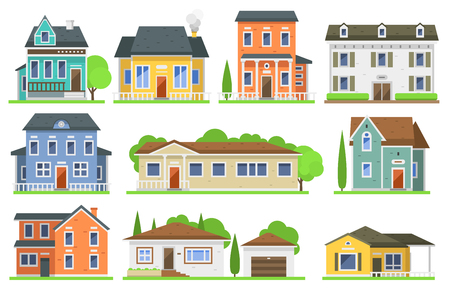1. Foundation and Structural Issues
When buying a home, one of the most serious red flags to look out for during a home inspection is foundation and structural problems. These issues can not only be expensive to repair but also compromise the safety and long-term stability of the property.
Common Signs of Structural Problems
Here are some warning signs that may indicate foundation or structural damage:
| Warning Sign | What It Might Mean |
|---|---|
| Cracks in the foundation | May signal settling, shifting, or water damage |
| Uneven or sloping floors | Could suggest foundation movement or structural failure |
| Doors and windows that won’t close properly | Might indicate shifting frames due to foundation issues |
| Bowing or leaning walls | A possible sign of pressure from soil or poor construction |
Why It Matters
If these problems are discovered during a home inspection, it’s crucial to consult a structural engineer for a professional evaluation. Repairs can range from minor fixes to major foundation work that can cost tens of thousands of dollars. Even worse, unresolved structural issues can lead to safety hazards and reduce the homes resale value.
What You Can Do as a Buyer
- If cracks or uneven floors are noted in the inspection report, ask for a specialist’s assessment.
- You may negotiate with the seller for repairs or request a price reduction based on repair estimates.
- If the problem is severe and the seller won’t address it, consider walking away from the deal.
2. Roof Problems
When it comes to buying a home, the roof is one of the most important parts to check during a home inspection. A damaged or aging roof can lead to expensive repairs down the road, so its crucial to spot any warning signs early on. Here are some common roof issues that inspectors and buyers should pay close attention to:
Common Roof Red Flags
| Red Flag | What It Might Mean |
|---|---|
| Missing Shingles | Can indicate storm damage or general wear and tear; may lead to leaks. |
| Water Stains in the Attic | Possible sign of current or past roof leaks; could mean moisture problems. |
| Sagging Areas | Could suggest structural damage or water accumulation weakening the roof deck. |
Why This Matters
A roof nearing the end of its lifespan can be a costly surprise for new homeowners. Replacing a roof can cost anywhere from $5,000 to over $15,000 depending on size and materials. Even smaller repairs can add up quickly if ignored. That’s why it’s smart to get a thorough evaluation during the inspection—and don’t hesitate to bring in a roofing specialist for a second opinion if anything looks off.
Questions to Ask During Inspection
- How old is the roof?
- Has it been repaired recently?
- Are there signs of poor installation or patchwork?
A solid roof means peace of mind. Spotting these red flags early helps you avoid unexpected costs and make a more informed decision about your potential new home.

3. Electrical System Hazards
One of the most critical areas to inspect in any home is the electrical system. Outdated or faulty electrical components can be a serious red flag during a home inspection. Not only do these issues pose fire hazards and safety risks, but they can also prevent you from getting homeowners insurance or passing local building codes.
Common Electrical Issues Found During Inspections
Some homes, especially older ones, may still have antiquated systems that no longer meet modern standards. Here are some common problems inspectors often find:
| Issue | Description | Potential Risk |
|---|---|---|
| Outdated Wiring (e.g., knob-and-tube or aluminum) | Old wiring systems not designed for modern power demands | Fire hazard, not insurable |
| Overloaded Electrical Panels | Panels with too many circuits or outdated capacity | Risk of overheating and fire |
| Ungrounded Outlets | Lack of grounding increases shock risk | Safety issue, non-compliant with code |
Why This Matters to Buyers
If your inspector flags any of these electrical issues, it could mean costly repairs down the line. For example, rewiring a house can cost thousands of dollars depending on the homes size and layout. Additionally, insurance companies may refuse coverage for homes with certain electrical hazards until theyre fixed.
What You Can Do
- Ask your inspector for detailed photos and explanations of any flagged electrical problems.
- Request an estimate from a licensed electrician before finalizing your purchase.
- If needed, negotiate repairs or price adjustments with the seller based on inspection results.
Being aware of potential electrical system hazards gives you the power to make safer and smarter buying decisions.
4. Plumbing Deficiencies
Plumbing problems can be a major red flag during a home inspection. While some issues might seem minor at first glance, they can point to deeper problems that could cost thousands in repairs later on. Here are the most common plumbing deficiencies that buyers should watch out for:
Common Signs of Plumbing Issues
When walking through a home or reviewing an inspection report, keep an eye out for these red flags:
| Issue | What It Could Mean |
|---|---|
| Leaky Pipes | May indicate aging plumbing or loose fittings; could lead to water damage or mold growth. |
| Poor Water Pressure | Could signal clogged pipes, mineral buildup, or issues with the main water line. |
| Water Damage Under Sinks | Might suggest ongoing leaks or past flooding; a breeding ground for mold. |
| Stains on Ceilings or Walls | A possible sign of leaking pipes hidden behind walls or between floors. |
Why Plumbing Problems Matter
A homes plumbing system is essential for daily comfort and sanitation. Hidden leaks can cause wood rot, attract pests, and even weaken the structure over time. In older homes, outdated piping materials like galvanized steel may need full replacement, which can be costly and time-consuming.
Tip for Buyers:
If an inspection reveals plumbing deficiencies, ask your real estate agent to request detailed evaluations from a licensed plumber. This can help you understand whether youre facing a simple fix or a complete overhaul.
5. HVAC System Concerns
When touring a home, the heating, ventilation, and air conditioning (HVAC) system might not be the first thing on your mind—but it should be. An aging or poorly maintained HVAC system can lead to high energy bills, poor indoor air quality, and unexpected breakdowns right when you need it most—like during a freezing winter night or a scorching summer day.
Why It Matters
The HVAC system is one of the most critical—and expensive—components in a home. If its not working properly, you could be facing thousands of dollars in repairs or replacement costs shortly after moving in. Plus, older systems tend to be less energy-efficient, which means higher utility bills month after month.
Common Red Flags to Watch For:
| Red Flag | What It Could Mean |
|---|---|
| Loud noises from furnace or AC | Poor maintenance or failing components |
| Uneven temperatures throughout the house | Ductwork issues or an undersized/oversized unit |
| No recent service records | The system may not have been properly maintained |
| A unit older than 15 years | Nearing the end of its lifespan; less efficient |
| Poor airflow from vents | Clogged filters, blocked ducts, or fan problems |
What You Can Do
If youre serious about a property, ask the seller for service records and find out the age of the HVAC system. During the home inspection, make sure the inspector tests both heating and cooling functions. If there are signs of trouble, consider asking for repairs or negotiating the cost into your offer.
Pro Tip:
If youre unsure about the condition of the HVAC system even after inspection, hire a licensed HVAC technician for a more detailed evaluation—it could save you major headaches down the road.
6. Signs of Mold or Water Damage
One of the most serious red flags during a home inspection is evidence of water damage or mold. These issues can be both costly to fix and harmful to your health. Knowing what to look for can help you avoid a bad investment.
Common Warning Signs
Here are some telltale signs that may indicate hidden moisture problems in the home:
| Warning Sign | What It Might Mean |
|---|---|
| Musty Odors | This smell often signals mold growth, even if it’s not visible. |
| Stains or Discoloration on Walls/Ceilings | These could point to past or ongoing leaks from plumbing or roofing. |
| Bubbling or Peeling Paint | A sign that moisture is trapped behind walls. |
| Soft or Warped Flooring | This could mean long-term water exposure under the surface. |
Why It Matters
Mold and water damage arent just cosmetic issues — they can lead to structural problems and cause respiratory issues, especially for people with allergies or asthma. Additionally, remediation can be expensive and time-consuming. In many cases, mold removal involves tearing out drywall, replacing insulation, and addressing the source of the leak.
What You Can Do
- If you suspect mold or water damage during an inspection, ask for further testing by a certified mold inspector.
- Your real estate agent may help negotiate repairs or price reductions based on the findings.
- If the issue is severe, it may be best to walk away from the deal.
The bottom line: don’t ignore musty smells or minor stains — they could be signs of much bigger problems lurking beneath the surface.

